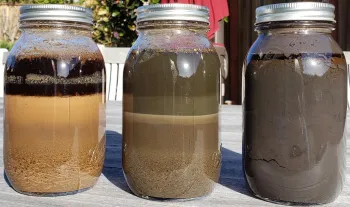Soil Tests to Evaluate Your Soil
Understanding the state of your soil will help you determine how healthy your soil is currently. Gardeners need to consider two critical aspects of their soil when deciding the conditions they need for the plants they want to grow: soil texture and soil structure.

Identify Your Soil Texture
Soil texture is the percentage of sand, silt and clay in your soil. It is the mineral portion of the soil, the parent rock that has been broken down over time into finer particles. Knowing your soil texture helps you make better garden decisions. While it is difficult to change the texture of your soil, you can improve drainage and aeration by adding compost and growing plants.
Most soils are classified based on the percentage of sand, silt and clay in the soil sample. You can run some simple tests to determine the classification of your soil.
Sand | Silt | Clay |
|---|---|---|
largest grain, | fine grain, | finest grain, |
The percentage of sand, silt and clay in your soil can be measured. There are 12 classes of soil texture, based on the relative percentages of sand silt and clay. These classes are represented by the different colors on the triangle. Soils composed primarily of sand and silt and lower amounts of clay are referred to as loams. A loam soil is about 40% sand, 40% silt and 20% clay.

Soils with over 30% clay easily compacts and water moves through it very slowly. Sandy soil will drain fast and cannot hold onto nutrients like clay soil. Silty soil will retain plant-available water better than sandy soils, can also hold onto nutrients, will compact very easily, and can develop a crust.
You can have your soil analyzed by a commercial lab to determine its texture, but there are a couple simple tests that you can carry out at home to determine the texture of your soil.
Mason Jar Test for Soil Texture
The Mason Jar Soil Sedimentation Test video (4:46), demonstrated by Santa Margarita Water District, explains what tools are needed, how to run the test and how to determine your soil texture.

Ribbon Test
Discover how to identify your soil texture by watching this Soil Texture by Feel video (4:04) from the UC Davis, Agricultural and Environmental Sciences, International Programs.
NOTE: When gathering a sample, try to find an area of your garden where the soil has not been amended, push mulch aside and collect the soil.
Perk Test for Soil Drainage
Knowing your soil texture helps inform how often and how long you water. You may need to water more frequently but for shorter periods of time in sandy soil compared to silty or clay soils.
Learn how to perform a DIY Soil Drainage Perk Test for Your Yard, from Today’s Homeowner.
Soil Stability Test
You can run a soil stability test to see if you have aggregates developing in your soil. This video from the USDA, Soil Health Lessons in a Minute: Soil Stability Test (1:12), explains how to do it.
Lab Testing
A soil lab test can provide a number of tests and recommendations which can be helpful. It can also prevent you from creating a problem by over fertilizing, over applying animal manures or unnecessarily adding too much gypsum, lime or sulfur.
The following lab tests can provide a good overview of your soil.
- Soil Texture - Percentage of sand, silt and clay, impacts air and water infiltration into soil
- pH - Measures soil acidity or alkalinity, which affects nutrient availability
- Organic Matter - a measure of soil health
- Cation exchange capacity (CEC) - the ability of soil to hold onto nutrients
- Macro, Secondary Macro and Micronutrients - at sufficient levels for the plant
- Salinity and Sodium - from over use of synthetic fertilizers, animal manures, well water. High levels of salinity can impact water availability, nutrients and soil structure
Follow the lab's instructions for taking samples. Remember that this is a snapshot in time, soil changes quickly especially if you are adding organic matter regularly and/or fertilizing. Take the soil sample before adding organic or synthetic fertilizers or amending the soil with compost. If you are interested in growing specific plants let the lab know, they can make recommendations based on the needs of the plant.
Running tests over time can help provide a baseline. Do run the test at the same time of year and use the same lab for ease of interpreting test results. A one time test for soil texture may be sufficient if you are gardening in the same area. Soil texture will not change over time. Organic matter will change over time. The % of organic matter is a good indicator of microbial activity in the soil. The microbial life in the soil will cycle nutrients to the plant. As organic matter increases in the soil you should find water moves easily into the soil, does not run off, and is held in small pore spaces in the soil so you don’t have to water as often.
Some labs can test well water and soil for contaminants. If you are using well water for your garden it is a good idea to have the water tested. Soil contaminants can be a concern if you are growing food or have children playing in the soil. Land that was used for agriculture or was an industrial site may contain contaminants.
- For more information, see the Soil Testing Labs for Home Gardeners handout from the UC Agriculture and Natural Resources Master Gardener Program.
- If you are concerned about heavy metals, see the Soils in Urban Agriculture: Testing, Remediation, and Best Management Practices article from the UC Agriculture and Natural Resources.
Header image courtesy of Pixabay. All images used with permission.
